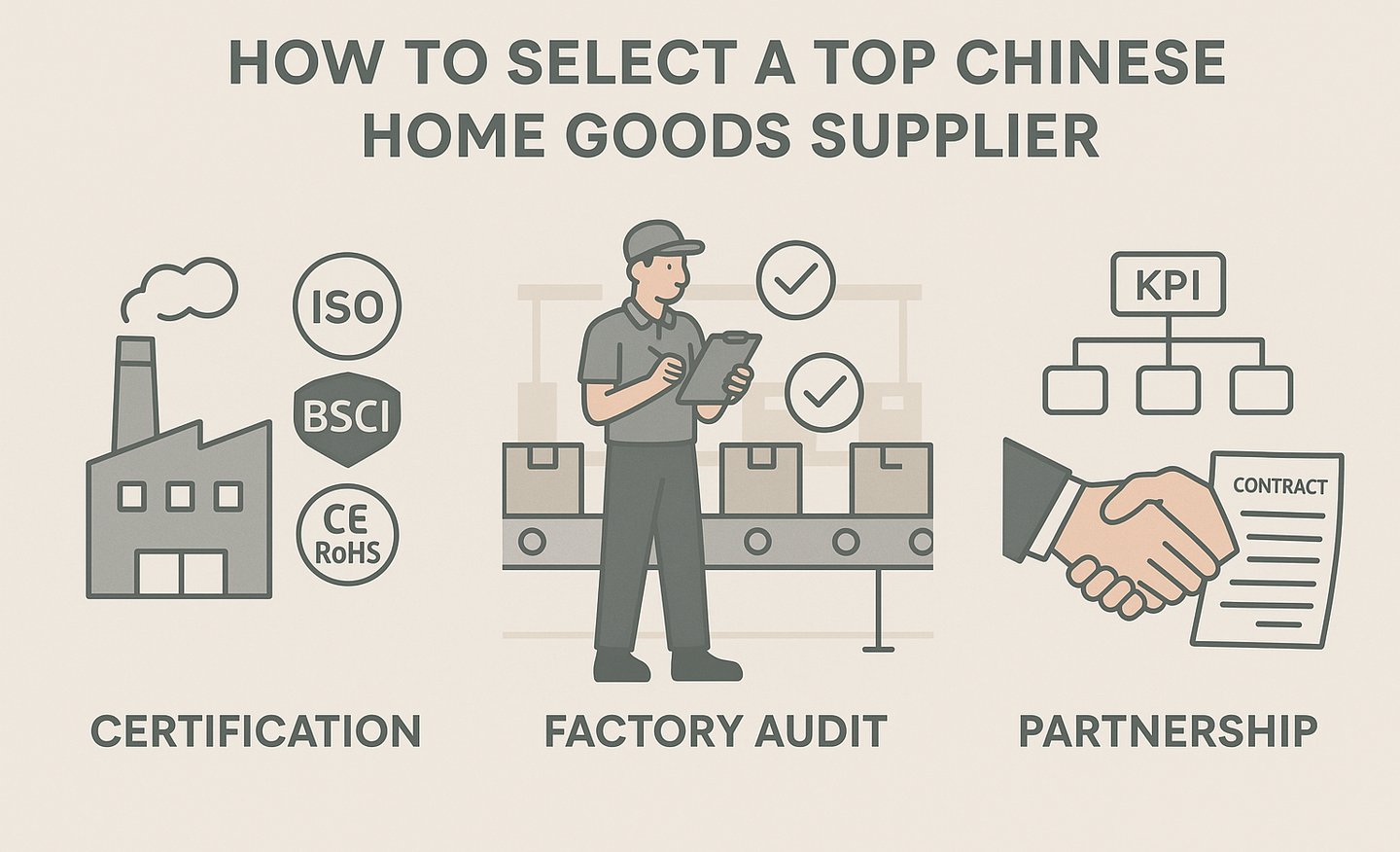Unlocking the Secrets to Selecting Top Chinese Home Goods Suppliers for Rock-Solid Procurement
With competition in the global home goods market intensifying, one of the biggest challenges for buyers is how to choose reliable Chinese suppliers—partners who can consistently deliver high quality, on-time shipments, and excellent service.
MANUFACTURING GUIDE
Koitor
8/8/20253 min read


With competition in the global home goods market intensifying, one of the biggest challenges for buyers is how to choose reliable Chinese suppliers—partners who can consistently deliver high quality, on-time shipments, and excellent service. A poor choice can lead to costly rework, delayed deliveries, and even damage to your brand’s reputation. This article dives deep into building a robust, efficient, and sustainable procurement supply chain through five key steps: factory certification, ten evaluation criteria, on-site factory audits, long-term supplier management, and a real-world case study.
1. Core Certifications and Quality Standards
Why Certifications Matter
Certifications are the first “ID card” of a supplier’s capability. Key certifications include:
ISO 9001 (Quality Management System): Demonstrates systematic processes from design and procurement through production and after-sales.
BSCI / Sedex (Social Responsibility): Covers labor rights, safety, and ethical compliance—vital for protecting your brand image.
CE / RoHS / REACH (Environmental & Safety): Ensures household goods meet European health, safety, and environmental requirements.
Industry-Specific (FDA / LFGB): Mandatory for kitchen and food-contact products.
Tip: Always verify certificates on-site to avoid expired or fraudulent documents.
2. Ten Critical Evaluation Criteria
Use a quantitative scoring model to compare suppliers on these ten factors:
Scoring Model:
Core factors (Quality, Delivery, Price, Service) each 20%
Secondary factors combined 20%
Total possible score: 100
3. On-Site Factory Audits to Mitigate Risk
Desk research and surveys can’t reveal true production capabilities—only factory audits can:
Preparation
Gather certificates, quality reports, third-party inspection records.
Create an audit checklist based on the ten criteria.
Assemble an audit team: procurement manager, quality lead, and (if needed) an external auditor.
Key Audit Focus Areas
5S & Workplace Cleanliness: Factory organization and visual controls.
Quality Control Process: Evidence of first-article, in-line, and final inspections.
Storage & Logistics: Segregation of raw materials, work-in-progress, and finished goods.
Safety & Environment: Fire safety, waste treatment, PPE usage.
Interviews: Speak with management, quality supervisors, and line operators.
Risk Identification & Corrective Actions
Common red flags: outdated certificates, idle equipment, missing SOPs.
Document findings with photos and define a timeline for corrective actions.
Post-Audit Evaluation
Score each factory vs. the audit checklist.
Conduct a SWOT analysis.
Place a sample order for final verification in customer labs and at headquarters.
4. Building Long-Term Partnerships
Selecting a supplier is just the start. Sustained success requires:
Clear Contracts: Define quality standards, delivery schedules, penalties, and bonuses.
Continuous Monitoring: Quarterly or annual audits; third-party inspections; KPI tracking for defect rates and on-time performance.
Mutual Investment: Joint development fund to upgrade key equipment; regular technical training.
Risk Contingency Plans: “Two mains, two backups” supplier structure; safety stock for critical materials; emergency response drills.
Supplier Development: Progress from OEM → ODM → Joint Development (JDM); launch strategic partnership programs with profit-sharing and co-marketing.
5. Real-World Case Study: A European Home Goods Brand’s Supply Chain Overhaul
Background
Original Supplier A: 8% defect rate, 85% on-time delivery, frequent peak-season delays.
Goal: Reduce defects below 2%, achieve 95%+ on-time delivery, establish a “two mains, two backups” network.
Step 1: Initial Research & Screening
Data Gathering: Identified 100 potential factories via trade shows, B2B sites, and referrals.
RFI Questionnaire: Collected data on the ten evaluation criteria.
Preliminary Elimination: Removed factories without ISO 9001/BSCI, <5,000 units/month capacity, or no CE/RoHS testing—leaving 15 candidates.
Step 2: Quantitative Scoring & Shortlisting
Applied the 100-point model in Excel.
Top 8 advanced to on-site audits; the rest became backups.
Step 3: On-Site Audits
Audit teams (procurement, quality, external auditor) inspected two factories each.
Criteria: 5S, QC processes, production lines, safety, environmental controls, and interviews.
Eliminated 3 factories; 5 remained for sample testing.
Step 4: Sample Testing & Final Selection
Ordered 3 SKUs × 50 units from each of the 5 factories.
Tested at headquarters and TÜV labs.
Factories A & B: <1.5% defect rate, 100% on-time delivery → selected as mains.
C, D, E: ≥3% defect rate → moved to backup pool.
Step 5: Ongoing Performance Management
KPI Tracking: Monthly reviews of defect rates, delivery rates, and complaint response times.
Joint Improvement Fund: Brand covered 30% of equipment upgrade costs; regular on-site technical training.
Results:
Defect rate improved from 8% → 0.8% (overall 99.2% pass rate).
On-time delivery rose from 85% → 98%.
Complaint response time reduced from 48h → 12h.
Conclusion
By combining rigorous certification checks, a quantitative evaluation model, thorough on-site audits, structured long-term partnership mechanisms, and lessons from real-world implementation, you can transform your supply chain from “many but weak” to “few but world-class.” This structured approach creates resilient, high-quality, and cost-effective procurement—your foundation for success in the competitive home goods market.
🏷️ Our Products
At Koitor Hardware, we specialize in providing custom, high-quality hardware solutions that are perfect for home organization. Each of our products is designed with both functionality and aesthetics in mind, ensuring they not only meet practical storage needs but also enhance the overall look of your space. As your trusted Chinese OEM partner, we offer a diverse range of tailored solutions to meet the unique demands of your business, from bathroom storage racks to kitchen organization systems and home accessories. Manufactured with precision and care, our products deliver durability, reliability, and efficiency.
Services
Get in Touch
simon@koitorhardware.com
Phone(Wechat):
+86-137-5033-6633
© 2025 Jiiangmen Koitor Hardware Co.,Ltd. All rights reserved.
Contact Us
Have questions or need a custom quote? Reach out to our team today!